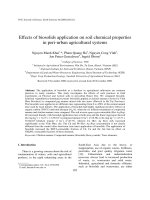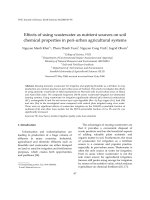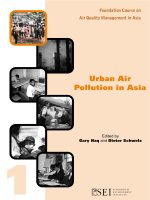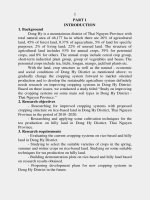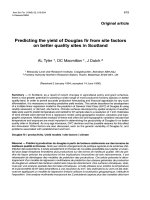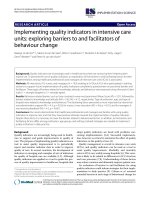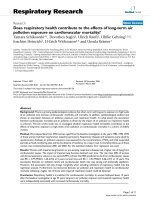Effects of long term rice-based cropping systems on soil quality indicators in central plain of Chhattisgarh
Bạn đang xem bản rút gọn của tài liệu. Xem và tải ngay bản đầy đủ của tài liệu tại đây (269.78 KB, 9 trang )
Int.J.Curr.Microbiol.App.Sci (2019) 8(4): 1544-1552
International Journal of Current Microbiology and Applied Sciences
ISSN: 2319-7706 Volume 8 Number 04 (2019)
Journal homepage:
Short Communications
/>
Effects of Long Term Rice-based Cropping Systems on Soil Quality
Indicators in Central Plain of Chhattisgarh
Uttam Kumar1*, V.N. Mishra1, Nirmal Kumar2, C.K. Dotaniya3 and Sandeep Mohbe3
1
Department of Soil Science and Agricultural Chemistry, Indira Gandhi Krishi
Vishwavidyalaya, Raipur, 492012, Chhattisgarh, India
2
ICAR-National Bureau of Soil Survey and Land Use Planning, Nagpur, 440033,
Maharashtra, India
3
ICAR -Indian Institute of Soil Science, Bhopal, 462038, M.P., India
*Corresponding author
Introduction
The definition of soil quality encompasses
physical,
chemical
and
biological
characteristics, and it is related to fertility and
soil health. Many indicators are used to
describe soil quality, but it is important to
take into account sensitivity, required time,
and related properties, than can be explained.
Soil physical, chemical, and biological
attributes (Karlen et al., 2001) have been used
historically as proxies to soil quality
(Andrews et al., 2002), which is a concept
related to intrinsic characteristics of the soil,
to its interactions with the ecosystem, and to
the type of land use or management. This
implies some degree of subjectivity as to
individual perceptions of what can be deemed
“good quality” (Blanco and Lal, 2008). More
recently, the discussion has been centered on
the concept of „soil health‟, largely defined
for soil biological properties (Doran and
Jones, 1996). Both concepts are focused on
assessing soil functions in the landscape, but
there is no explicit reference state to be used
in a soil quality or health framework. Soil
quality indicators are normally chosen
according to the research focus. The dataset
of indicators may be constructed according to
expert opinion (Sanchez-Navarro et al.,
2015), based on how often the parameters
appear in scientific papers or it may be guided
solely on statistical criteria. Certainly, it can
also consist of the combination of both
strategies (Lima et al., 2013). However,
comparing soil quality indicators is not an
easy task, since there is neither a consensus as
to the appropriate indicators to compose the
SQI, nor as to the way that they should be
selected to minimize personal subjectivity.
According to USDA, soil quality indicators
are classified into four categories that include
visual, physical, chemical, and biological
indicators. Visual indicators can be obtained
through field visits, perception of farmers,
and local knowledge. These are identified
through
observation
or
photographic
1544
Int.J.Curr.Microbiol.App.Sci (2019) 8(4): 1544-1552
interpretation, subsoil exposure, erosion,
presence of weeds, color, type of coverage,
and through comparison between systems
operated with the unaudited interim
anthropogenic, which gives a clear idea
whether the soil quality has been affected
positively or negatively.. The physical
indicators are related to the organization of
the particles and pores, reflecting effects on
root growth, speed of plant emergence and
water infiltration; they include depth, bulk
density, porosity, aggregate stability, texture
and compaction. Chemical indicators include
pH, salinity, organic matter content,
phosphorus availability, cation exchange
capacity, nutrient cycling, and the presence of
contaminants such as heavy metals, organic
compounds, radioactive substances, etc.
These indicators determine the presence of
soil-plant-related
organisms,
nutrient
availability, water for plants and other
organisms, and mobility of contaminants.
Finally,
biological
indicators
include
measurements of micro- and macroorganisms, their activities or functions.
Concentration or population of earthworms,
nematodes, termites, ants, as well as microbial
biomass, fungi, actinomycetes, or lichens can
be used as indicators, because of their role in
soil development and conservation; nutrient
cycling and specific soil fertility. Due to the
variety of soil properties that can act as
quality indicators, researchers should identify
and select the most suitable ones according to
the research goals (Nortcliff, 2002). Keeping
these points in mind the present study was
conducted objective of this work was to study
impact of different rice-based cropping
system on soil quality indictors under hot
humid eastern plateau of India for further
evaluation of soil quality.
The study area (Balod district) is a part of
Chhattisgarh state of India, lies between
20˚24‟ to 21˚03‟ N latitude and 80˚47‟ to
81˚31‟ E longitude, at an elevation of 324 m
above the mean sea level, which occupies an
area of 3527 sq. km. In Balod district survey
was carried out and identified two important
soil orders i.e. Inceptisols and Vertisols. The
prominent cropping sequences identified for
detailed study were; rice – wheat (RW), rice –
chickpea (RC), rice – lathyrus (RL) and rice –
fallow (RF). Rice crop was sown as an
autumn–winter crop (July to November) and
subsequent crops i.e. wheat, chickpea and
lathyrus were grown as winter–spring crop
(November to February). Stratified soil
sampling was adopted and 10% of the total
villages in the district were taken into
consideration. In each village, based on the
cropping system, soil samples were taken
from Inceptisols and Vertisols, where the crop
rotation was followed since 2000. After the
harvest of cropping system for each soil
sample, five points (0- 15 cm) were taken into
account before compositing. A total 40
samples were collected (20 samples for each
cropping system), air dried and sieved under
shade. The fine earth (< 2 mm) was analyzed
for soil physical, chemical, and biological
properties following standard laboratory
procedures (Table 1).
Soil physical properties
The mean values of BD of soils were 1.40,
1.34, 1.36 and 1.37 Mg m -3 for RW, RC, RL,
and RF cropping system, respectively (Table
2). The higher amount of added biomass from
leguminous crops (chickpea and lathyrus)
made soil loose, porous and less squeezed.
Therefore, the lower BD was found under
rice-legume cropping system (RC and RL)
(Rahman et al., 2007). The mean values of
PD of soils were 2.65, 2.64, 2.63 and 2.63Mg
m-3 for RW, RC, RL, and RF cropping
system, respectively (Table 2). The PD of
soil only affected by size of the particles,
therefore, the PD of soils was found to be no
difference among the cropping systems
(Alam and Salahin, 2013). The mean values
1545
Int.J.Curr.Microbiol.App.Sci (2019) 8(4): 1544-1552
of porosity of soils were 47.07, 49.16, 48.11
and 47.92 per cent for RW, RC, RL, and RF,
respectively (Table 2). The greater extant of
added biomass from leguminous crops made
soil porous, increase macro pores, makes the
soil more voluminous (Bandyopadhyay et al.,
2011). Accordingly, the higher porosity was
found under rice- legume cropping system.
The mean values of FC of soils were 24.50,
32.45, 27.95, and 26.55 per cent for RW,
RC, RL, and RF cropping system,
respectively (Table 2). The mean values of
WC of soils were 16.00, 21.45, 18.80, and
16.20 per cent for RW, RC, RL, and RF
cropping system, respectively (Table 2). The
FC and WC of soils under RC and RL
cropping system was higher than that of soils
under RW and RF. Rice-legume cropping
system added large amount of biomass in to
the soil, which make surface soil loose and
porous, thus enhance the capacity of soil to
store and retain more moisture (Alam and
Salahin 2013; Kumar et al., 2018). The mean
values of WHC of soils were 33.95, 50.42,
36.68, and 35.74 per cent for RW, RC, RL,
and RF cropping system, respectively (Table
2). Rice-legume cropping system (RC) store
large extant of carbon in to the soil. By the
decomposition
of
organic
matter,
polysaccharides, fulvic acid and humic acid
are produced, which bind soil particles,
increase mean weight diameter, improve
water stable aggregates, and consequently
increase in WHC of soil (Bama and
Somasundaram 2017; Kumar et al., 2018).
The mean values of HC of soils were 0.83,
0.85, 0.90, and 0.86 cm hr-1 for RW, RC, RL,
and RF cropping systems, respectively
(Table 2). Rice-legume cropping system
notable for organic carbon build-up in soils,
which improves soils aggregation (Cotching
et al., 2002), reduces pH and ESP and
enhance the hydraulic conductivity of the
soils (Bhattacharyya et al., 2000). The mean
values of MWD of soils were 0.70, 0.86,
0.79, and 0.71 mm for RW, RC, RL, and RF,
respectively (Table 2). Rice-legume cropping
system (RC and RL) having high root mass
density, mean root diameter, root diameter
diversity and the percentage of fine roots was
all positively linked to the stability of soil
aggregates by increasing SOC content. Higher
root biomass of leguminous crops helped to
accumulation of higher amount of SOC
through roots and leaf-fall with increased
macro-aggregate formation.
Soil chemical properties
The mean values of soil pH were 7.2, 6.5, 6.7
and 6.8, for RW, RC, RL, and RF,
respectively (Table 2). The soil pH of soils
under RC cropping system was lower than
that of soils under RL, RF and RW cropping
system. This result has been accredited to the
well-known soil acidification effects induced
by leguminous crops (Burle et al., 1997).
Legume plants reliant on N2 fixation take up
more cations than anions, resulting in a net
export of protons. The mean values of soil
EC were 0.16, 0.14, 0.12, and 0.13 dS m-1 for
RW, RC, RL, and RF cropping system,
respectively (Table 2). The EC of soils was
found to be no difference among the
cropping systems (Table 2). The mean values
of soil OC were 4.08, 5.8, 4.9, 4.5 g kg-1 for
RW, RC, RL, and RF cropping system,
respectively (Table 2). Higher SOC was
observed in the rice-legume cropping system
(RC and RL) may be attributed to these
rotations was considered to have high root
biomass, higher carbon sequestration capacity
and less carbon release than that of soils
under RW and RF cropping system (Mitsch
et al., 2010). The mean values of soil CEC
were 37.35, 46.76, 41.53 and 39.58 cmol (p+)
kg-1 for RW, RC, RL, and RF, respectively
(Table 2). Rice-legume cropping system
store large extant of carbon content in to soil
and high carbon content might be responsible
for higher CEC. The mean values of
available N of soils were 220.32, 246.95,
1546
Int.J.Curr.Microbiol.App.Sci (2019) 8(4): 1544-1552
232.72, and 225.30 kg ha-1 for RW, RC, RL,
and RF, respectively (Table 2). Legume is a
natural mini-nitrogen manufacturing factory
in the field. Legumes playing a pivotal role
especially in N supply to the cereals by
symbiotic association between legume roots
and rhizobium bacteria. As a result, ricelegume cropping system (RC and RL) store
more N rather than RW and RF (Kumar et al.,
2018).The mean values of available P of soils
were 15.5, 19.20, 17.6, and 15.90 kg ha-1 for
RW, RC, RL, and RF, respectively (Table 2).
A greater P availability was observed under
RC cropping system presumably due to the
lower pH. Crop rotations, especially those
with legumes, can increase root colonization
by mycorrhizae. Mycorrhizal associations
have the greatest impact on increasing P
availability for crops by colonizing root
(Newton et al., 2011). The mean values of
available K of soils were 355.78, 439.90,
391.40, and 371.80 kg ha-1 for RW, RC, RL,
and RF cropping system, respectively (Table
2). The available K of soils under RW
cropping system was lower than that of soils
under RC and RL. The mean values of
available S of soils were 13.65, 17.00, 15.15,
and 13.65 kg ha-1 for RW, RC, RL, and RF,
respectively (Table 2). The available S of
soils under RW cropping system was lower
than that of soils under RC and RL.
Similarly, the available S of soils under RC
cropping system was higher than that of soils
under RL and RF.
Soil biological properties
The mean values of soil MBC were 201.98,
234.38, 193.21, and 217.14 ppm for RW,
RC, RL, and RF, respectively (Table 2). The
mean values of soil MBN were 771.53,
830.76, 787.08, 783.48 ppm for RW, RC,
RL, and RF, respectively (Table 2). Soils
under rice-legume crop rotations with a high
input and diversity of organic materials are
reported to contain higher concentrations of
microbial biomass and enzymes as compared
with RW and RF cropping systems (Moore et
al., 2000; Kumar et al., 2018). The mean
values of soil PMC were 406.29, 429.08,
405.85, and 410.82 ppm for RW, RC, RL,
and RF, respectively (Table 2). The mean
values of soil PMN were 158.11, 202.78,
164.40, 179.04 ppm for RW, RC, RL, and
RF, respectively (Table 2). Retention of crop
residue on or near the soil surface has been
shown to reduce residue carbon loss and
increase SOC over time (Lal 2004). High
SOC content, biomass production, microbial
activity and lower C: N ratio might be
responsible for higher carbon and nitrogen
mineralization under rice-legume cropping
system (Justin et al., 2015). Carpenter-Boggs
et al., (2000) reported that crop rotations
differing in crop components could have large
effects on PMN and N availability by altering
the quantity and quality of residue input. The
mean values of acid phosphatase activity of
soil were 78.37, 92.00, 90.75, and 83.37 µg
p-nitrophenol g-1 24 hr-1 for RW, RC, RL,
and RF, respectively (Table 2). The mean
values of alkali phosphatase activity of soil
were 259.55, 308.60, 308.41, and 274.17 µg
p-nitrophenol g-1 24 hr-1 for RW, RC, RL,
and RF, respectively (Table 2). Rice-legume
cropping system responsible for high SOC
content, biomass production, microbial
population and activity, consequently enhance
mycorrhizae association. The rhizosphere is
directly influenced by root and mycorrhizae
secretions of phosphatase enzyme, and
sustains dense populations of root-associated
and free-living microorganisms. Therefore,
soil under rice-legume cropping system
contains large quantities of intracellular and
extracellular phosphatases. The mean values
of urease activity of soil were The 20.66,
31.41, 25.57, and 24.02 µg NH4-N g-1 24 hr-1
for RW, RC, RL, and RF, respectively
(Table 2).
1547
Int.J.Curr.Microbiol.App.Sci (2019) 8(4): 1544-1552
Table.1 Analytical method adopted for soil physical, chemical, and biological properties
Parameters
Soil texture
Reference to method of analysis
International pipette method (Piper, 1950)
Method No. 39, USDA Hand book No. 60 (Richards, 1954)
Bulk density (BD)
Method No. 39, USDA Hand book No. 60 (Richards, 1954)
Particle density (PD)
By calculating BD and PD.
Porosity
Keen raczkowski box method (Piper, 1950)
Water holding capacity (WHC)
Using pressure plate membrane apparatus as described by
Soil moisture retention (SMR) at
-33 kpa (FC) and -1500 kpa (WP) Kumar et al. (2018a)
Constant head method (Klute and Dirksen, 1986).
Hydraulic conductivity
Yoder‟s Modified weight sieving method (Yoder, 1936)
Aggregate stability
(Mean weight diameter)
pH Meter method No. 21(b), USDA Hand book No. 60
pH
(Richards, 1954)
EC Meter (in soil suspension) method No. 04 (b), USDA
Electrical conductivity (EC)
Hand book No. 60 (Richards, 1954)
Walklay and Black‟s wet digestion method (1934)
Soil organic carbon (SOC)
Method No. 19, USDA Hand book No. 60 (Richards,
Cation exchange capacity (CEC)
1954)
Alkaline KMnO4 method (Subbiah and Asija, 1956)
Available N
Olsen‟s method as described by Kumar et al. (2018a)
Available P
Neutral normal ammonium acetate method with flame
Available K
photometer (Jackson, 1950).
Turbidimetric method as described by Kumar et al.
Available S
(2018a)
Jenkinson and Powelson (1976)
Microbial biomass C and N
Anderson (1982)
Potentially mineralized C and N
Klein et. al. (1971)
Dehydrogenases activity
Tabatabi and Bremner (1969) using borate buffer pH 9.4
Acid and alkaline
phosphatase activity
Urease activity
Pancholy and Rice (1973)
1548
Int.J.Curr.Microbiol.App.Sci (2019) 8(4): 1544-1552
Table.2 Descriptive statistics of soil properties among different cropping system
Mean
1.40
2.65
47.07
24.50
16.00
33.95
0.83
0.70
7.2
0.16
4.08
37.35
220.32
15.5
355.78
13.65
201.98
771.53
406.29
158.11
78.37
Rice – Wheat
Min.
1.29
2.58
42.86
16.50
10.40
18.48
0.68
0.58
6.8
0.04
2.60
23.24
177
9.2
187
7.10
149.59
645.62
326.35
107.75
62.35
Max.
1.49
2.74
50.57
32.50
21.60
43.43
1.07
0.82
7.6
0.32
6.1
51.47
251
21.8
459
20.20
254.38
897.45
486.24
208.48
94.39
Mean
1.34
2.64
49.16
32.45
21.45
50.42
0.85
0.86
6.5
0.14
5.8
46.76
246.95
19.20
439.90
17.00
234.38
830.76
429.08
202.78
92.00
Rice – Chickpea
Min.
1.27
2.59
46.21
26.70
15.10
42.52
0.67
0.76
5.2
0.08
4.7
34.28
199
14.50
387
12.70
197.49
778.74
359.58
159.78
85.35
Max.
1.44
2.69
51.71
38.20
27.80
58.33
0.96
0.98
7.5
0.23
6.7
59.24
275
23.90
501
21.30
271.12
882.78
498.59
245.79
98.65
Rice – Lathyrus
Mean
Min.
Max.
1.36
1.29
1.44
2.63
2.57
2.71
48.11
45.17
52.22
27.95
21.10
34.80
18.80
12.50
25.10
36.68
20.42
52.95
0.90
0.71
1.06
0.79
0.64
0.99
6.7
5.2
7.9
0.12
0.03
0.26
4.90
3.4
6.4
41.53
21.51
61.56
232.72
164
261
176
10.40
24.80
391.40
318
475
15.15
10.40
19.90
193.21
128.48
257.94
787.08
678.57
95.59
405.85
304.35
507.35
164.40
129.84
198.96
90.75
62.96
118.54
Mean
1.37
2.63
47.92
26.55
16.20
35.74
0.86
0.71
6.8
0.13
4.5
39.58
225.38
15.9
371.80
13.65
217.14
783.48
410.82
179.04
83.37
259.55
208.24
310.86
308.60
259.86
357.34
308.41
248.24
368.59
274.17
202.35
345.61
20.66
10.57
30.75
31.41
24.25
38.58
25.57
11.68
39.47
24.02
11.48
36.57
29.51
15.53
43.49
40.12
31.67
48.57
35.79
21.84
49.79
32.84
16.35
49.34
Soil Property
BD (Mg m-3)
PD (Mg m-3)
Porosity (%)
SMR % (-33 kpa)
SMR % (-1500 kpa)
WHC (%)
HC (cm hr.-1)
MWD (mm)
pH
EC
OC (g kg-1)
CEC [cmol (p+) kg-1]
Av. N (kg ha-1)
Av. P (kg ha-1)
Av. K (kg ha-1)
Av. S (kg ha-1)
MBC (ppm)
MBN (ppm)
PMC (ppm)
PMN (ppm)
Acid phosphatase activity
(µg p-nitrophenol g-1 24 hr-1)
Alkali phosphatase activity
(µg p-nitrophenol g-1 24 hr-1)
Urease activity
(µg NH4-N g-1 24 hr-1)
Dehydrogenase activity
(µg TPF g-1 24 hr-1)
1549
Rice – Fallow
Min.
Max.
1.29
1.47
2.52
2.74
44.44
51.29
21.50
31.60
10.80
21.60
14.65
56.84
0.66
1.10
0.60
0.85
5.40
8.2
0.02
0.28
2.6
6.4
19.68
59.48
186
258
8.7
23.10
267
138
7.10
20.20
164.35
269.94
668.54
901.42
348.84
472.81
115.74
242.35
62.35
104.39
Int.J.Curr.Microbiol.App.Sci (2019) 8(4): 1544-1552
Rice-legume cropping system stimulate
microbial activity which build-up OC and
microbial biomass in to the soil (Campbell et
al., 2000). Higher microbial biomass carbon
and nitrogen under rice-legume cropping
system attributed to the greater urease
activity. The mean values of DHA of soil
were 29.51, 40.12, 35.79, 32.84 µg TPF g-1
24 hr-1 for RW, RC, RL, and RF, respectively
(Table 2). Rice-legume cropping systems
were found significantly higher DHA might
be due to higher microbial activity which was
registered in the present study itself.
Dehydrogenases are greatly associated with
microbial biomass, which in turn mediates the
decomposition of organic materials (Zhang et
al., 2010).
From the results it is concluded that soil
quality indicators were registered optimum
for rice- legume cropping systems (RC and
RL) than that of RW and RF cropping
systems. Optimum in terms of lower BD,
higher porosity, HC, MWD, FC, WHC,
available macro- and micro-nutrient status,
and high in soil microbial activities.
Therefore, to perform soil functions and to
sustain productivity rice-legume cropping
system could be more effective.
References
Alam, M.K. and Salahin, N. 2013.Changes in
soil physical properties and crop
productivity as influenced by different
tillage depths and cropping patterns.
Bangladesh Journal of Agricultural
Research, 38(2): 289-299.
Anderson, J.P.E. 1982. Soil respiration. In
Methods of soil analysis, part 2, 2nd ed.
Page, A.L., Miller, R.H. and Keeney,
D.R. 837–871. Madison, Wisconsin,
American Society of Agronomy and
Soil Science Society of America.
Andrews, S.S., Karlen, D.L. and Mitchell, J.P.
2002. A comparison of soil quality
indexing methods for vegetable
production systems in Northern
California. Agriculture, Ecosystems and
Environment 90, 25-45.
Bama, K.S. and Somasundaram, E. 2017. Soil
quality changes
under
different
fertilization and cropping in a Vertisol
of Tamil Nadu. International journal of
chemical studies, 5(4): 1961-1968.
Bandyopadhyay, P.K., Saha, S. and Mallick,
S. 2011. Comparison of soil physical
properties between a permanent fallow
and a long-term rice–wheat cropping
with inorganic and organic inputs in the
humid subtropics of eastern India.
Communications in Soil Science and
Plant Analysis, 42: 435–449. DOI:
10.1080/00103624.2011.542358.
Blanco, H. and Lal, R. 2008. Principles of soil
conservation
and
management.
Dordrecht. Springer, p. 617.
Burle, M.L., Mielniczuk, J. and Focchi, S.
1997. Effect of cropping systems on soil
chemical characteristics, with emphasis
on soil acidification. Plant and Soil,
190: 309–316.
Campbell, C.A., Zenter, R.P., Selles, F.,
Biederbeck, V.O., McConkey, B.G. and
Blomert, B. 2000. Quantifying shortterm effects of crop rotations on soil
organic carbon in southwestern
Saskatchewan. Canadian Journal of Soil
Science, 80: 193-202.
Carpenter-Boggs, L., Pikul, J.L., Jr., Vigil,
M.F. and Riedell, W.E. 2000. Soil
nitrogen mineralization influenced by
crop rotation and nitrogen fertilization.
Soil Science Society of America
Journal, 64: 2038-2045.
Cotching, W.E., Cooper, J., Sparrow, L.A.,
McCorkell, B.E., Rowley, W. and
Hawkinds, K. 2002. Effects of
agricultural management on Vertisols in
Tasmania. Australian Journal of Soil
Research, 40: 1267– 1286.
Doran, J.W. and Jones, A.J. (Eds.) 1996.
1550
Int.J.Curr.Microbiol.App.Sci (2019) 8(4): 1544-1552
Methods for assessing soil quality.
Special Publication, vol. 49, Soil
Science Society of America, Madison,
WI.
Jackson, M.L. 1950. Soil Chemical Analysis.
(Indian Edition), Prentice Hall of India
Ltd. Delhi.
Jenkinson, D.S. and Powlson, D.S. 1976. The
effect of biological treatments on
metabolism in soil. A method for
measuring soil biomass. Soil Biology
and Biochemistry, 8: 209-213.
Justin, K., Dea, O., Jones, C.A., Zabinski,
C.A., Miller, P.R. and Keren, I.N. 2015.
Legume, cropping intensity, and Nfertilization effects on soil attributes and
processes from an eight-year-old
semiarid
wheat
system.
Nutrient Cycling in Agro ecosystems,
102: 179–194.
Karlen, D.L., Andrews, S.S. and Doran, J.W.
2001. Soil quality: current concepts and
applications. Advances in Agronomy,
74: 1-40.
Klein, D.A., Loh, T.C. and Goulding, R.L.
1971. A rapid procedure to evaluate
dehydrogenases activity of soils low in
organic matter. Soil Biology and
Biochemistry, 3: 385–387.
Klute, A. 1986. Water retention: laboratory
methods. In: Klute, A. (Ed.), Methods
of Soil Analysis, second ed. Elsevier,
Madison, WI, pp. 635 –662 (pt. 1).
Kumar, U., Mishra, V.N., Kumar, N., 2018.
Comparative study of soil quality
indicators for rice-based cropping
system in Vertisols of central plain of
Chhattisgarh. Asian Journal of Soil
Science
13(2),
136-147.
DOI:
10.15740/HAS/AJSS/13.2/136-147.
Kumar, U., Mishra, V.N., Kumar, N.,
Rathiya, G.R., 2018a. Methods of Soil
Analysis. Kalyani Publishers, Ludhiana,
pp. 17-22.
Lal, R. 2014. Soil carbon sequestration
impacts on global climate change and
food security. Science, 304:1623–1627.
doi: 10.1126/science.1097396.
Lima, A.C.R., Brussaard, L., Totola, M.R.,
Hoogmoed, W.B. and Goede, R.G.M.
2013. A functional evaluation of three
indicators sets for assessing soil quality.
Applied Soil Ecology, 64: 194- 200.
Mitsch, W.J., Nahlik, A., Wolski, P., Bernal,
B., Zhang, L. and Ramberg, L. 2010.
Tropical wetlands: seasonal hydrologic
pulsing, carbon sequestration, and
methane emissions. Wetlands Ecology
and Management, 18: 573–586.
Moore, J.M., Susanne, K. and Tabatabai,
M.M. 2000. Soil microbial biomass
carbon and nitrogen as affected by
cropping systems. Biology and Fertility
of Soils, 31: 200–210.
Nortcliff, S. 2002. Standardization of soil
quality
attributes.
Agriculture
Ecosystem and Environment, 88: 161–
168.
Pancholy, S.L. and Rice, E.L. 1973. Soil
enzymes in relation to old field
succession:
amylase,
cellulose,
invertase, dehydrogenase and urease.
Soil Science Society of America.
Proceedings, 37: 47-50.
Piper, C.S. 1950. Soil and Plant Analysis.
Hans Publishers, Mumbai, pp. 368
Rahman, M.N., Rahman, M.M., Islam, M.B.,
Begum, R.A. and Mondol, A.T.M.A.I.
2007. Effect of tillage practices on soil
properties and moisture conservation
under Maize -GM-T. Aman cropping
sequence. Annual Research Report, Soil
Science
Division,
Bangladesh
Agricultural
Research
Institute,
Gazipur.
Richards, L.A. 1954. Diagnosis and
improvement of saline-alkali soils.
USDA Handbook No. 60, U.S.
Department of Agriculture, Will
Washington, D.C.
Sanchez-Navarro, A., Gil-Vasquez, J.M.,
Delgadoiniesta,
M.J.,
Marin-
1551
Int.J.Curr.Microbiol.App.Sci (2019) 8(4): 1544-1552
Sanleandro, P., Blancobernardeau, A.
and Ortiz-Silla, R. 2015. Establishing an
index and identification of limiting
parameters of characterizing soil quality
in Mediterranean ecosystems. Catena,
131: 35-45.
Subbiah, B.V. and Asija, G.L. 1956. A rapid
procedure for the determination of
available nitrogen in soils. Current
Sciences, 25: 259-260.
Tabatabi, M.A. and Bremner, J.M. 1969. Use
of p-nitro phenyl phosphate for asses of
phosphate activity. Soil Biology and
Biochemistry, 1: 301-307.
Yoder, R.E. 1936. A direct method of
aggregate analysis of soils and a Study
of the physical nature of erosion losses.
Agronomy Journal, 28: 337-351.
Zhang, W.J., Wang, X.J., Xu, M.G., Huang,
S.M., Liu, H., Peng, C. 2010. Soil
organic carbon dynamics under longterm fertilizations in arable land of
northern China. Biogeosciences, 7: 409425.
How to cite this article:
Uttam Kumar, V.N. Mishra, Nirmal Kumar, C.K. Dotaniya and Sandeep Mohbe. 2019. Effects
of Long Term Rice-based Cropping Systems on Soil Quality Indicators in Central Plain of
Chhattisgarh- Short Communications. Int.J.Curr.Microbiol.App.Sci. 8(04): 1544-1552.
doi: />
1552
